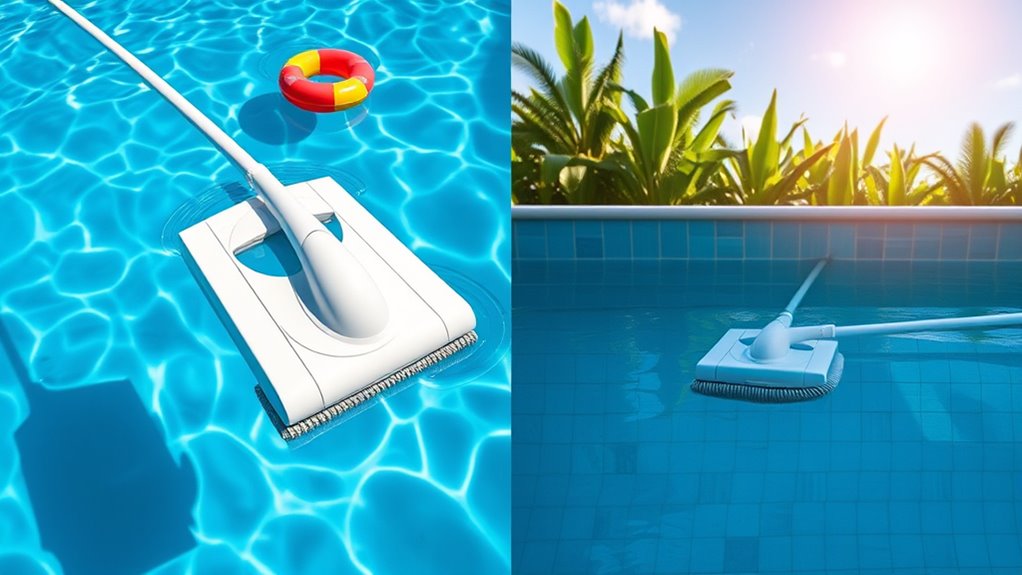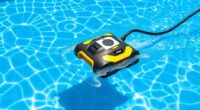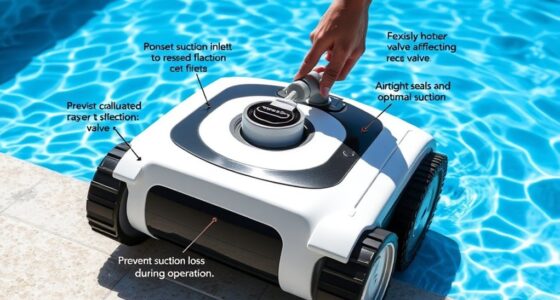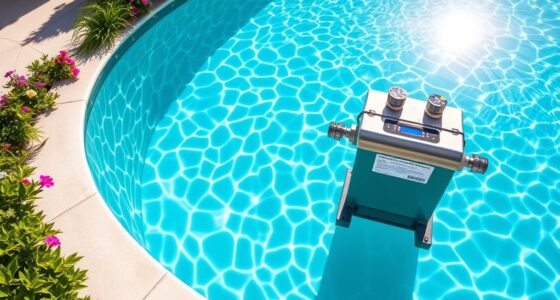Using suction pool cleaners in above-ground versus in-ground pools varies based on size, shape, and surface. Above-ground pools are simpler and easier to clean, requiring less powerful pumps and quicker setup, while in-ground pools often have complex design features needing stronger pumps and precise installation. Properly matching your cleaner to your pool type improves effectiveness and longevity. Keep in mind that environmental factors also impact performance. To get expert tips and troubleshooting advice, explore more details ahead.
Key Takeaways
- Above-ground pools typically require smaller, less powerful suction cleaners due to their simpler shape and surface, enabling quicker cleaning.
- In-ground pools often need more robust, adjustable suction cleaners to navigate complex shapes, variable depths, and textured surfaces effectively.
- Pump power should match pool type; moderate pumps suit above-ground pools, while higher capacity pumps are better for in-ground pools.
- Installation for above-ground pools is generally easier with simpler hose connections, whereas in-ground pools may need customized setups for optimal coverage.
- Regular maintenance and water chemistry management are essential for both pool types to ensure cleaner efficiency and longevity of the suction system.
Differences in Pool Size and Design
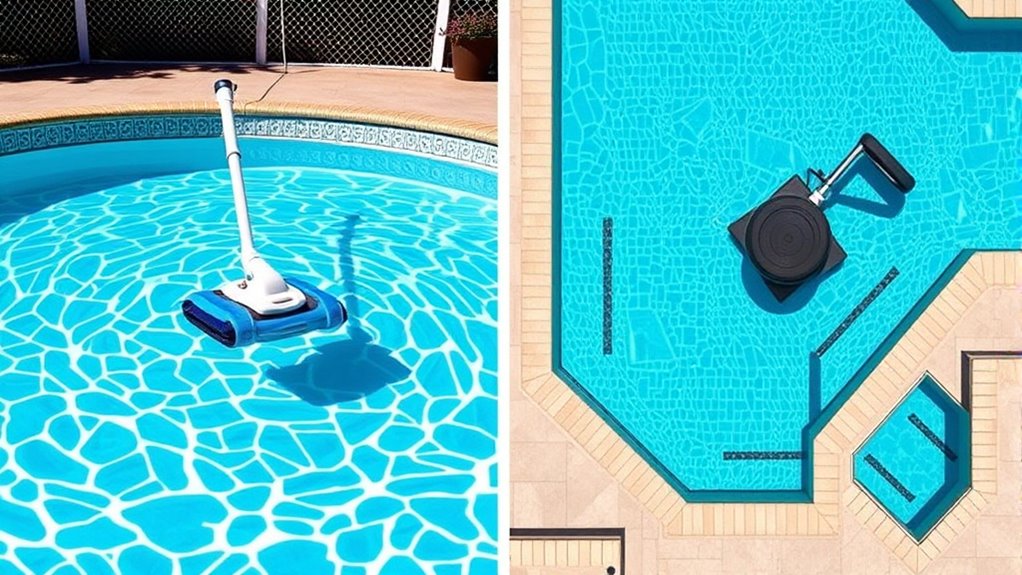
The size and design of your pool considerably influence how effectively a suction pool cleaner works. Larger pools require more powerful or longer-running cleaners to cover the entire area efficiently. In-ground pools often have complex shapes and varying depths, which can make cleaning more challenging. You might need a cleaner with adjustable settings or additional hoses to reach all corners. Additionally, the complexity of pool layout can affect the navigation and effectiveness of the cleaner. Conversely, above-ground pools usually have simpler, more uniform shapes, allowing a suction cleaner to work more quickly and thoroughly. Pool design also affects navigation; irregular shapes or steps can hinder a cleaner’s ability to reach every spot. Understanding your pool’s size and layout helps you select a suction cleaner that performs ideally, ensuring it cleans thoroughly without unnecessary strain or missed spots. Pool layout and shape are critical factors that determine the overall effectiveness of a suction pool cleaner.
Compatibility of Suction Cleaners With Pool Types
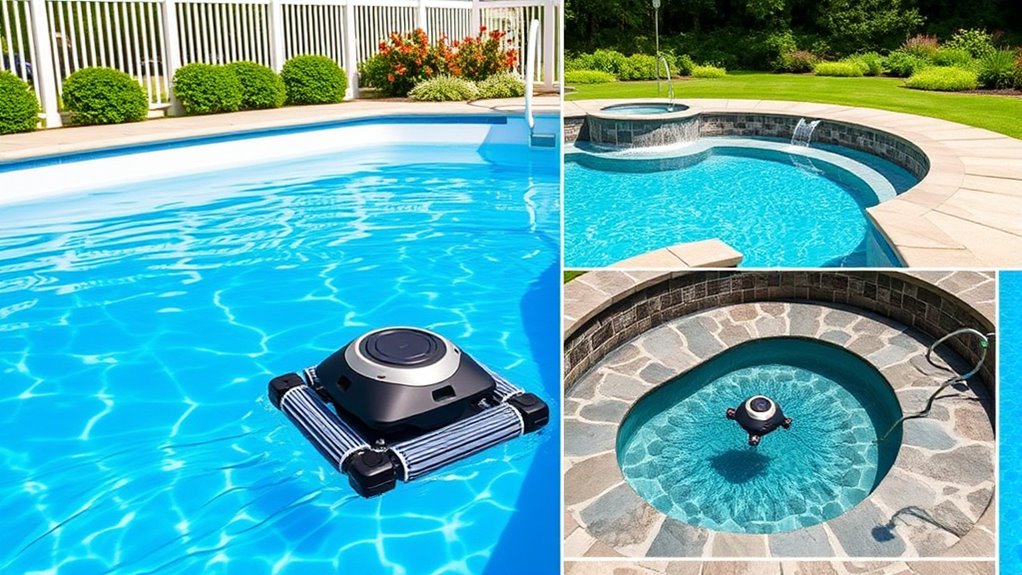
You need to guarantee your suction cleaner matches your pool’s surface, whether it’s plaster, vinyl, or fiberglass. Additionally, check if your pool’s pump has enough power to operate the cleaner effectively. Proper compatibility helps your cleaner work efficiently and prevents potential damage. For optimal performance, consider selecting a shower designed for your specific pool type and size. Ensuring the self watering plant pots are suitable for your garden conditions can also extend their lifespan and effectiveness. Recognizing the importance of material compatibility in ensuring durability can help you choose the right pool equipment for your environment. Being aware of electric motor horsepower can also impact the efficiency of your pool cleaner and its ability to handle different pool surfaces. Understanding these factors can significantly improve your cleaning results and equipment longevity.
Pool Surface Compatibility
Suction pool cleaners are generally effective across various pool surfaces, but their compatibility depends on the material and texture of the pool’s interior. If your pool has a rough plaster finish or textured surface, the cleaner’s brushes can scrub away algae growth more effectively. Smooth vinyl or fiberglass surfaces tend to require gentler cleaning to avoid damage. It’s important to take into account water chemistry, as imbalanced water can promote algae growth and affect the cleaner’s performance on different surfaces. Using a cleaner suited for your pool type ensures thorough debris removal without scratching or damaging the surface.
- Concrete and plaster pools often need vigorous cleaning tools
- Vinyl liners are delicate and require softer brushes
- Fiberglass surfaces resist scratches better
- Textured surfaces trap debris more easily
- Proper water chemistry reduces algae buildup and enhances cleaning efficiency
Pump Power Requirements
Matching pump power to your pool type is essential for ideal suction cleaner performance. For above-ground pools, a pump with moderate power offers good energy efficiency while keeping noise levels low, making it suitable for smaller spaces. In-ground pools often require more powerful pumps to handle larger surface areas and deeper water, but this can increase noise levels and energy consumption. Guarantee your pump matches your pool’s size and the cleaner’s specifications to optimize cleaning efficiency and minimize energy waste. A pump that’s too weak won’t provide sufficient suction, leading to poor cleaning, while an overly powerful pump can cause unnecessary noise and higher energy bills. Proper pump compatibility ensures your suction cleaner operates smoothly, quietly, and efficiently across different pool types. Additionally, selecting the right pump can help improve cognitive function and focus during maintenance tasks, making the process more manageable and less stressful. Ensuring your pump’s compatibility with pool type can also extend the lifespan of your equipment and prevent costly repairs.
Installation and Setup for Various Pools
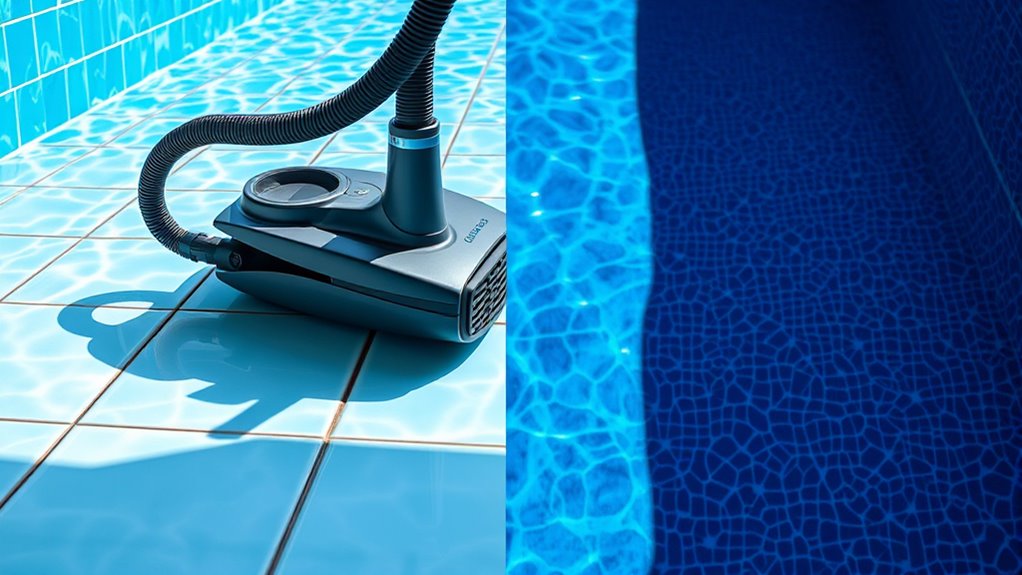
Installing and setting up suction pool cleaners varies depending on your pool type, but the process generally involves connecting the cleaner to the skimmer or dedicated suction line and guaranteeing proper water flow. You’ll want to verify that your pool’s filtration system can handle the cleaner’s requirements. Be sure to check the safety features of the cleaner to prevent accidents, especially if kids or pets are around. Additionally, maintaining balanced pool chemicals helps the cleaner perform at its best and prevents buildup. Here are key steps to contemplate:
- Confirm compatibility with your pool type
- Connect hoses securely to prevent leaks
- Adjust water flow for effective cleaning
- Regularly inspect for clogs or debris
- Ensure safety features are active and functional
- Monitoring vacuum cleaner performance metrics can help optimize cleaning efficiency and prolong the lifespan of your equipment. Regularly reviewing pool filtration efficiency can also ensure that your system is functioning optimally to support the cleaner’s operation. Incorporating hybrid systems that combine different cleaning technologies can further improve overall pool maintenance. Additionally, understanding digital literacy programs and their benefits can enable you to better utilize your pool’s smart features and maintenance tools. Moreover, staying informed about pool system upgrades can enhance your ability to keep the pool clean and safe.
Effectiveness and Cleaning Performance

To guarantee your suction pool cleaner performs effectively, it’s important to enhance water flow and monitor its cleaning patterns regularly. Adjust the flow rate to ensure the cleaner moves smoothly across your pool surface, preventing missed spots. The cleaning cycle duration plays a key role; shorter cycles may leave debris behind, while longer ones improve debris pickup efficiency. For in-ground pools, the cleaner often covers the area more thoroughly due to consistent water flow, enhancing overall effectiveness. In above-ground pools, you might need to adjust placement or cycle times to achieve similar results. Consistent observation helps identify any dead zones or inefficient coverage, allowing you to tweak settings for ideal debris pickup efficiency and a cleaner, clearer pool.
Maintenance and Longevity of Cleaners

To keep your suction pool cleaner working its best, you need to understand the factors that cause wear and tear. Regular maintenance, like cleaning filters and checking hoses, can prolong its lifespan. By following proper care practices, you ensure your cleaner stays effective for years to come.
Wear and Tear Factors
Suction pool cleaners are generally durable, but their longevity depends heavily on how well you maintain them and the conditions they operate in. Wear and tear factors can accelerate breakdowns if you don’t stay attentive. Exposure to harsh chemicals, fluctuating water levels, and debris can cause parts to deteriorate faster. Poor chemical balance can promote algae growth, clogging filters and damaging internal components. Regularly inspecting and cleaning your cleaner helps prevent unnecessary strain. Additionally, sharp objects or rough surfaces can cause abrasions on hoses and brushes. Environmental factors such as UV rays and sunlight can also weaken plastic components over time, reducing overall lifespan. Implementing proper maintenance routines can significantly extend the life of your pool cleaner. Moreover, ensuring the pool water’s chemical levels remain balanced helps minimize corrosion and damage to internal parts, further prolonging its service life. Awareness of wear and tear factors such as chemical exposure and environmental conditions can help you schedule timely repairs and replacements, ensuring your cleaner remains effective. Regularly replacing worn parts and following manufacturer guidelines also contribute to maintaining optimal cleaner performance.
Proper Maintenance Practices
Maintaining your suction pool cleaner properly can ensure its lifespan is extended and it operates efficiently. Regularly check that your pool’s chemical balance stays within recommended levels to prevent corrosion and buildup that can damage the cleaner’s components. During seasonal closures, clean and store the cleaner in a cool, dry place to avoid unnecessary wear. Inspect hoses and brushes for debris or damage and replace parts as needed. Rinse the cleaner thoroughly after use to remove dirt and chemicals. Keep the filter and intake area clear for ideal suction. Proper maintenance reduces the risk of malfunctions and prolongs the cleaner’s effectiveness, saving you money in the long run. Consistent care is key to maximizing your suction pool cleaner’s performance and durability. Using vetting practices for your equipment can further enhance its longevity and reliability.
Cost Considerations and Budgeting

When considering the purchase of a suction pool cleaner, it’s vital to evaluate your budget carefully, as costs can vary widely depending on features and brand. Proper budget planning helps you avoid overspending and guarantees you get the best value. Conduct a thorough cost comparison between models to identify options that fit your financial limits. Keep in mind that in-ground pool cleaners tend to be more expensive upfront but might save money long-term through durability. Here are some factors to consider:
- Initial purchase price
- Installation and setup costs
- Maintenance and replacement parts
- Energy consumption
- Potential repair expenses
Balancing these costs ensures you select a cleaner that meets your needs without breaking your budget. Being strategic with your spending guarantees a hassle-free pool cleaning experience.
Tips for Optimal Use and Troubleshooting
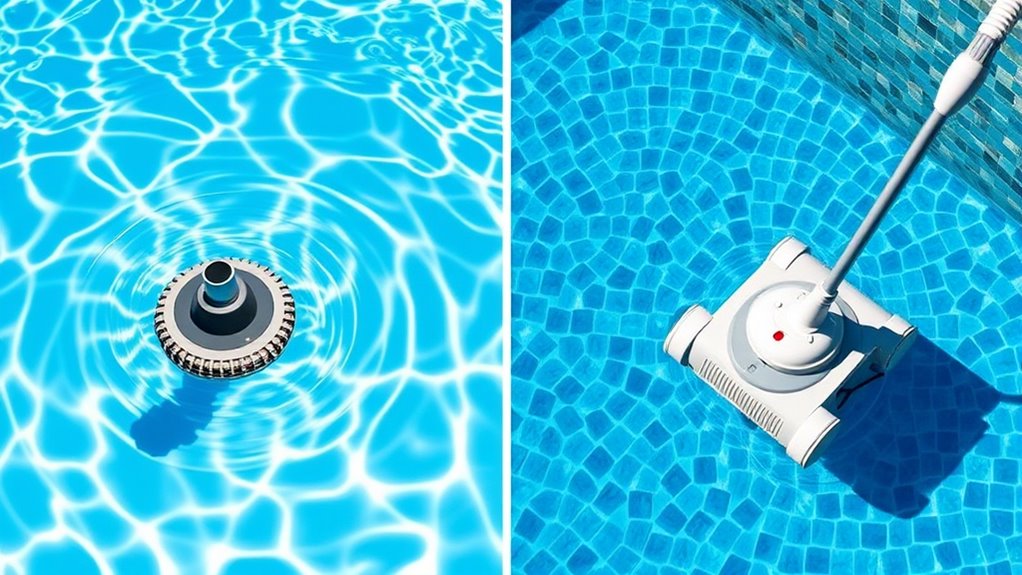
To guarantee your suction pool cleaner operates at its best, it’s important to follow some key tips for ideal use and quick troubleshooting. First, ensure your pool’s chemical balance is correct; imbalanced water can hinder cleaning efficiency and cause equipment issues. Regularly perform seasonal cleaning to remove debris and prevent buildup that can clog the cleaner. Check the skimmer and pump baskets frequently, especially after storms or heavy use. Make sure the hose is free of kinks and leaks, which can reduce suction power. If you notice reduced cleaning performance, inspect for obstructions or worn parts. Maintaining proper chemical levels and staying on top of seasonal cleaning helps your suction cleaner work smoothly, saving you time and preventing unnecessary repairs.
Frequently Asked Questions
Can Suction Pool Cleaners Be Used With Saltwater Pools?
Yes, suction pool cleaners can be used with saltwater pools. They’re generally saltwater compatible, but you should check the cleaner’s specifications for pool material considerations. Some parts, like the hoses or seals, might be affected by salt over time. To guarantee longevity, choose a model specifically designed for saltwater pools or that clearly states saltwater compatibility. Regular maintenance helps prevent corrosion and keeps your cleaner working efficiently.
Are Suction Cleaners Suitable for Pools With Intricate or Irregular Shapes?
Ever notice how your pool’s irregular shapes and complex designs seem to challenge even the best tools? Suction cleaners work well for pools with irregular shapes, as they adapt to tricky corners and tight spots. You’ll appreciate how they navigate around curves and complex layouts, making cleaning easier. Just guarantee your model’s compatible with your pool’s design, and you’ll enjoy sparkling water without the hassle.
Do Suction Cleaners Require Additional Accessories for Above-Ground Pools?
You’ll find that suction cleaners generally don’t need extra accessories for above-ground pools, but you should check pool cover compatibility to guarantee it won’t interfere. Also, confirm electrical wiring requirements—most suction cleaners need a proper power source, which might mean an outdoor outlet or GFCI protection. This ensures safe operation without risking electrical hazards. So, a quick review of these factors helps you choose the right cleaner for your above-ground pool.
How Often Should Suction Pool Cleaners Be Serviced or Replaced?
You should perform regular maintenance on your suction pool cleaner, ideally every few months, to keep it functioning well. The replacement schedule depends on usage and wear, but typically, you’ll need to replace parts like brushes or hoses every 1-3 years. Keep an eye on performance, and if cleaning becomes ineffective or repairs cost too much, it’s time for a new cleaner. Proper maintenance guarantees longevity and efficient pool cleaning.
Are There Safety Concerns When Using Suction Cleaners in Different Pool Types?
Imagine a child getting caught in a suction pool cleaner because it was too powerful for the pool type. Safety concerns include ensuring the cleaner’s suction power matches the pool’s design, preventing entrapment or damage. For example, above-ground pools with less robust walls risk damage, while in-ground pools need secure fittings. Always check manufacturer guidelines to reduce risks from pool debris or excessive suction, keeping your family safe.
Conclusion
Choosing between above-ground and in-ground pool cleaners isn’t just a matter of size; it’s about harmony between your pool’s design and your cleaning needs. Like a well-conducted symphony, the right suction cleaner guarantees sparkling water without hassle. By understanding the differences, you’ll master the art of maintenance, making your pool inviting and pristine. After all, a clean pool isn’t just a goal—it’s the masterpiece you create with every careful choice.

